2011年数字集成电路设计期末考试试卷_中国科技大学
电子技术期末考试题及答案
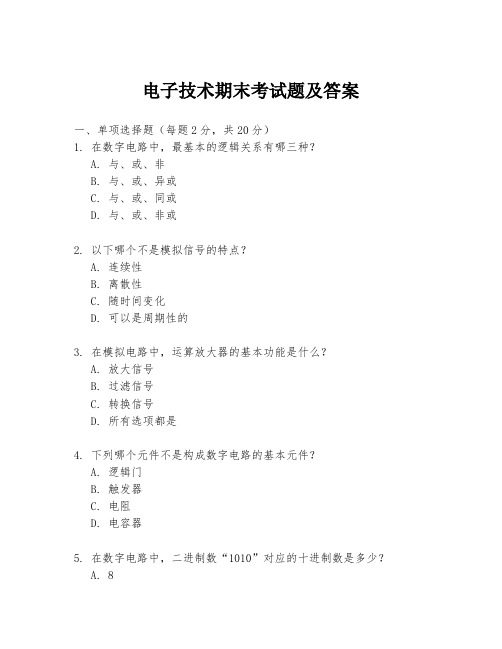
电子技术期末考试题及答案一、单项选择题(每题2分,共20分)1. 在数字电路中,最基本的逻辑关系有哪三种?A. 与、或、非B. 与、或、异或C. 与、或、同或D. 与、或、非或2. 以下哪个不是模拟信号的特点?A. 连续性B. 离散性C. 随时间变化D. 可以是周期性的3. 在模拟电路中,运算放大器的基本功能是什么?A. 放大信号B. 过滤信号C. 转换信号D. 所有选项都是4. 下列哪个元件不是构成数字电路的基本元件?A. 逻辑门B. 触发器C. 电阻D. 电容器5. 在数字电路中,二进制数“1010”对应的十进制数是多少?A. 8B. 10C. 16D. 206. 以下哪个是半导体材料的主要特性?A. 导电性B. 绝缘性C. 半导体性D. 磁性7. 一个逻辑门输出高电平的条件是什么?A. 输入端至少有一个高电平B. 输入端全部为高电平C. 输入端全部为低电平D. 输入端至少有一个低电平8. 以下哪个是数字信号的特点?A. 连续性B. 离散性C. 随时间变化D. 可以是周期性的9. 一个完整的数字系统通常由哪两个部分组成?A. 硬件和软件B. 输入和输出C. 逻辑和非逻辑D. 模拟和数字10. 以下哪个是数字电路的优点?A. 抗干扰能力强B. 功耗高C. 体积大D. 集成度低二、填空题(每空2分,共20分)11. 晶体管的三种基本工作状态分别是______、______和饱和。
12. 一个基本的RS触发器由两个______组成。
13. 在数字电路中,逻辑“0”通常对应电压______,逻辑“1”通常对应电压______。
14. 运算放大器的开环增益可以非常高,通常可以达到______以上。
15. 一个完整的数字电路系统包括输入设备、______、输出设备和电源。
16. 半导体材料的导电能力介于导体和绝缘体之间,因此被称为______。
17. 在数字电路中,一个基本的逻辑门可以是______、与门、或门、非门等。
《数字集成电路》期末试卷(含答案)

浙江工业大学 / 学年第一学期 《数字电路和数字逻辑》期终考试试卷 A姓名 学号 班级 任课教师一、填空题(本大题共10小题,每空格1分,共10分)请在每小题的空格中填上正确答案。
错填、不填均无分。
1.十进制数(68)10对应的二进制数等于 ;2.描述组合逻辑电路逻辑功能的方法有真值表、逻辑函数、卡诺图、逻辑电路图、波形图和硬件描述语言(HDL )法等,其中 描述法是基础且最直接。
3.1A ⊕可以简化为 。
4.图1所示逻辑电路对应的逻辑函数L 等于 。
A B L≥1&CYC图1 图25.如图2所示,当输入C 是(高电平,低电平) 时,AB Y =。
6.两输入端TTL 与非门的输出逻辑函数AB Z =,当A =B =1时,输出低电平且V Z =0.3V ,当该与非门加上负载后,输出电压将(增大,减小) 。
7.Moore 型时序电路和Mealy 型时序电路相比, 型电路的抗干扰能力更强。
8.与同步时序电路相比,异步时序电路的最大缺陷是会产生 状态。
9.JK 触发器的功能有置0、置1、保持和 。
10.现有容量为210×4位的SRAM2114,若要将其容量扩展成211×8位,则需要 片这样的RAM 。
二、选择题(本大题共10小题,每小题2分,共20分)在每小题列出的四个备选项中只有一个是符合题目要求的,请将其代码填写在题后的括号内。
错选、多选或未选均无分。
11.十进制数(172)10对应的8421BCD 编码是 。
【 】A .(1111010)8421BCDB .(10111010)8421BCDC .(000101110010)8421BCD D .(101110010)8421BCD12.逻辑函数AC B A C B A Z +=),,(包含 个最小项。
【 】A .2B .3C .4D .513.设标准TTL 与非门AB Z =的电源电压是+5V ,不带负载时输出高电平电压值等于+3.6V ,输出低电平电压值等于0.3V 。
数字电路2011期末考试题-参考解答

电子科技大学2010 -2011学年第二学期期末考试 A 卷课程名称:_数字逻辑设计及应用__ 考试形式:闭卷考试日期:20 11 年7 月7 日考试时长:_120___分钟课程成绩构成:平时30 %,期中30 %,实验0 %,期末40 %本试卷试题由__六___部分构成,共__6___页。
I. Fill your answers in the blanks(2’ X 10=20’)1. A parity circuit with N inputs need N-1XOR gate s. If the number of “1” in an N logic variables set, such as A、B、C、…W, is even number, then__________A B C W⊕⊕⊕⋅⋅⋅⋅⊕=0 .2. A circuit with 4 flip-flops can store 4bit binary numbers, that is, include 16 states at most.3. A modulo-20 counter circuit needs 5 D filp-flops at least. A modulo-288 counter circuit needs 3 4-bit counters of 74x163 at least.4. A 8-bit ring counter has 8 normal states. If we want to realize the same number normal states, we need a 4bit twisted-ring counter.5. If the input is 10000000 of an 8 bit DAC, the corresponding output is 5v. Then an input is 00000001 to the DAC, the corresponding output is 5/128 (0.0391) V; if an input is 10001000, the corresponding DAC output is 5.3125V.II. Please select the only one correct answer in the following questions.(2’ X 5=10)B ) chips of 4K ⨯4 bits RAM to form a 16 K ⨯ 8 bits RAM.A) 2 B) 8 C) 4 D) 162. To design a "01101100" serial sequence generator by shift registers, we need a( A)-bit shift register as least.A) 5 B) 4 C) 3 D) 63. For the following latches or flip-flops, ( B) can be used to form shift register.A) S-R latch B) master-slave flip-flop C) S-R latch with enable D) S’-R’ latch4. Which of the following statements is correct? ( C )A) The outputs of a Moore machine depend on inputs as well as the states.B) The outputs of a Mealy machine depend only on the states.C) The outputs of a Mealy machine depend on inputs as well as the states. D) A), B), C) are wrong.5. There is a state/output table of a sequential machine as the table 1, what the input sequences isdetected? ( D )A) 11110 B) 11010 C) 10010 D) 10110Table 1III.Analyze the sequential-circuit as shown in figure 1. [15’]1. Write out the excitation equations, transitionequations and output equation. [5’]2. Assume the initial state is Q 2Q 1=00, complete thetiming diagram for Q 2 ,Q 1 and Z.( Don ’t need consider propagation delay of each component)[10’]Figure-1解答:激励方程: D 1=Q 1⊕Q 2,D 2= Q /1+ Q /2转移方程:Q 1 *= D 1=Q 1⊕Q 2,Q 2 *=D 2= Q /1+ Q /2 输出方程:Z= Q 1•Q 2IV. Design a Mealy sequential detector with one input x and one output z. If and only if xdescribe the state meaning and finish the state/output table. [15] Example : x :0 1 0 1 1 1 1 0 0 1 1 0 0 1 1 1 1 1 z :0 0 0 0 0 0 1 0 0 1 0 0 0 1 0 0 1 1XState meaningS 0 1 Initial A A,0 B,0 Received 1 B C,0 D,0 Received 10 C E,0 B,0 Received 11 D C,0 F,0 Received 100 E A,0 B,1 Received 111 F C,0F,1S*,ZV. Analyze the circuit as shown below, which contains a 74x163 4-bit binary counter, a 74x138[15’] ’ output F. [5’]2. Write out the sequence of states for the 74x161 in the circuit. [7’]3. Describe the modulus(模) of the circuit. [3’]解答:F=D2=Y6/=(QDQCQBQA /)/ 状态序列:0,1,2,3,4,5,6,7,8,9,10,11,12,13,14,0,1,2,… M=15VI.the state transition sequence is 0→2→4→1→3→0→…with the binary code. 1. Fill out the transition/output table. [8’]2. Write out the excitation equations and output equation. [4’]3. List the complete transition/output table, and check the self-correct. [3’] transition/output table : 74X161的功能表输入 当前状态 下一状态 输出CLR_L LD_L ENT ENP QD QC QB QA QD* QC* QB* QA* RCO 0 X X X X X X X 0 0 0 0 1 0 X X X X X X D C B A 1 1 0 X X X X X QD QC QB QA 1 1 X 0 X X X X QD QC QB QA 1 1 1 1 0 0 0 0 0 0 0 1 1 1 1 1 0 0 0 1 0 0 1 0 1 1 1 1 0 0 1 0 0 0 1 1 1 1 1 1 0 0 1 1 0 1 0 0complete transition/output table:输出方程:Z=Q1Q0检查自启动:当Q2Q1Q0=101,可得下一状态为001;当Q2Q1Q0=110,可得下一状态为101;当Q2Q1Q0=111,可得下一状态为001。
电子科大模电期末真题10~11.doc

电子科大模电期末真题10~11学院___________________ 系别____________ 班次_____________ 学号__________ 姓名________________………….……密…..……….封……..……线………..…以………..…内………....答…………...题…………..无…….….效…..………………..电子科技大学二零一零至二零一一学年第 1 学期期末考试模拟电路基础课程考试题A卷(120 分钟)考试形式:开卷考试日期2011年1 月 5 日课程成绩构成:平时20 分,期中20 分,实验0 分,期末60 分一二三四五六七八九十合计复核人签名得分签名一、填空题(共30分,共 15个空格,每个空格2 分)1、共发射极放大器(NPN管),若静态工作点设置偏高,可能产生_饱和__失真,此时集电极电流会出现__上___(上、下)削峰失真。
2、某晶体管的极限参数P CM = 200 mW,I CM = 100 mA,U(BR)CEO = 30 V,若它的工作电压U CE为10 V,则工作电流不得超过20 mA;若工作电流I C = 1 mA,则工作电压不得超过30 V。
4、电路及直流测试结果如图1所示,分别指出它们工作在下列三个区中的哪一个区(恒流区、夹断区、可变电阻区)。
得图1(a) 恒流区 ; (b) 可变电阻区 。
5、由三端集成稳压器构成的直流稳压电路如图2所示。
已知W7805的输出电压为5V ,I Q =10 mA ,晶体管的β=50,|U BE |=0.7 V ,电路的输入电压U I =16 V ,三极管处于放大 (放大,饱和,截止)状态, R 1上的电压为 5.7 V ,输出电压U o 为 9 V 。
图26、设图3中A 均为理想运放,请求出各电路的输出电压值。
U 01= 6 V; U 02= 6 V; U 03= 4 V; U 04= 10 V; U 05= 2 V; U 06= 2 V 。
《数字集成电路》期末试卷B(含答案)

浙江工业大学 / 学年第一学期 《数字电路和数字逻辑》期终考试试卷B姓名 学号 班级 任课教师一、填空题(本大题共10小题,每空格1分,共10分)请在每小题的空格中填上正确答案。
错填、不填均无分。
1.(1011111.01)2=( )102.若10010110是82421BCD 码的一组代码,则它对应的十进制数是________。
3.逻辑函数B A AB F +=的反函数F =________。
4.不会出现的变量取值所对应的最小项叫做 。
5.组合逻辑电路任何时刻的稳定输出仅仅只决定于__________各个输入变量的取值。
6.描述时序逻辑电路的逻辑表达式有驱动方程、________________和输出方程。
7.1K ×4位ROM ,有 位地址输入。
8.要把模拟量转化成数字量一般要经过四个步骤,分别称为采样、保持、________、编码。
9.D/A 转换器的主要参数有 、转换时间和转换精度。
10.集成单稳态触发电路的暂稳态维持时间取决于 。
二、选择题(本大题共10小题,每小题2分,共20分)在每小题列出的四个备选项中只有一个是符合题目要求的,请将其代码填写在题后的括号内。
错选、多选或未选均无分。
11.若已知Y XY YZ Z Y XY +=++,判断等式=+++))()((Z Y Z Y Y X Y Y X )(+成立的最简单方法是依据 规则。
【 】A .代入规则B .对偶规则C .反演规则D .互补规则12.F (A ,B ,C )的任意两个最小项之积等于 。
【 】 A .0 B .1 C .ABC D .ABC13.+0+1A A A ⋅⋅等于 。
【 】 A .0 B .1 C . A D .A 14.将TTL 与非门正常使用时,多余的输入端应 。
【 】 A .全部接高电平 B .部分接高电平,部分接地 C .全部接地 D .部分接地,部分悬空 15. S R 触发器不具有 功能。
第一学期《数字电子技术》课程期末考试试卷A和答案数字电路与逻辑设计
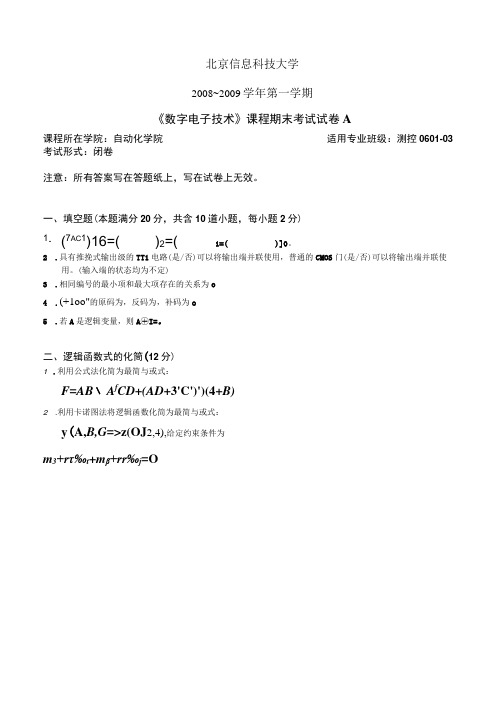
北京信息科技大学2008~2009学年第一学期《数字电子技术》课程期末考试试卷A课程所在学院:自动化学院适用专业班级:测控0601-03考试形式:闭卷注意:所有答案写在答题纸上,写在试卷上无效。
一、填空题(本题满分20分,共含10道小题,每小题2分)1∙(7AC1)16=( )2=( 1=( )]0。
2.具有推挽式输出级的TT1电路(是/否)可以将输出端并联使用,普通的CMOS门(是/否)可以将输出端并联使用。
(输入端的状态均为不定)3.相同编号的最小项和最大项存在的关系为o4.(+1oo"的原码为,反码为,补码为o5.若A是逻辑变量,则A㊉I=。
二、逻辑函数式的化筒(12分)1 .利用公式法化简为最简与或式:F=AB∖A f CD+(AD+3'C')')(4+B)2 .利用卡诺图法将逻辑函数化简为最简与或式:y(A,B,G=>z(OJ2,4),给定约束条件为m3+rτ‰t+mβ+rr‰j=O下面电路图中,写出输出信号是什么状态(高电平、低电平或高阻态),已知乂为74系四、试用一片8选1数据选择器74HC151产生逻辑函数:Y=AB r CD÷48(C÷r>)+ABXCΦZ))÷ABC r 要求给出设计的全过程,并画出逻辑电路图。
(12分)s ,A2A4YO O O OO O O1O∣O O1O D1O O11O1O OO1O1/人O11O2O11151X X X高阻五、TT1主从JK触发器的输入波形如图所示,画出输出端Q的波形(12分)CP六、分析如图时序逻辑电路的逻辑功能,写出电路的驱动方程、状态方程和输出方程,画出电路的状态转换图,说明电路的功能以及能否自启动。
(14分)CP七、 试用一片4位同步二进制计数器741S163接成十进制计数器(允许附加必要的门电路,采用清零法),并作简要说明。
741S163的引脚图如下所示。
电子科大数字电路,期末试题101102半期考试试卷-答案
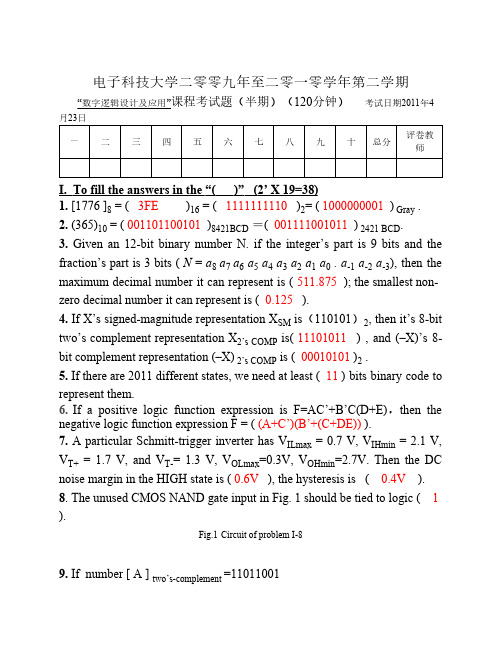
电子科技大学二零零九年至二零一零学年第二学期“数字逻辑设计及应用”课程考试题(半期)(120分钟)考试日期2011年4月23日一二三四五六七八九十总分评卷教师I. To fill the answers in the “( )” (2’ X 19=38)1. [1776 ]8 = ( 3FE )16 = ( 1111111110 )2= ( 1000000001 ) Gray .2. (365)10 = ( 001101100101 )8421BCD=( 001111001011 ) 2421 BCD.3.Given an 12-bit binary number N. if the integer’s part is 9 bits and the fraction’s part is 3 bits ( N = a8 a7 a6 a5 a4 a3 a2 a1 a0 . a-1 a-2 a-3), then the maximum decimal number it can represent is ( 511.875 ); the smallest non-zero decimal number it can represent is ( 0.125 ).4. If X’s signed-magnitude representation X SM is(110101)2, then it’s 8-bit two’s complement representation X2’s COMP is( 11101011 ) , and (–X)’s 8-bit complement representation (–X) 2’s COMP is ( 00010101 )2 .5. If there are 2011 different states, we need at least ( 11 ) bits binary code to represent them.6.If a positive logic function expression is F=AC’+B’C(D+E),then the negative logic function expression F = ( (A+C’)(B’+(C+DE)) ).7. A particular Schmitt-trigger inverter has V ILmax = 0.7 V, V IHmin = 2.1 V, V T+= 1.7 V, and V T-= 1.3 V, V OLmax=0.3V, V OHmin=2.7V. Then the DC noise margin in the HIGH state is ( 0.6V ), the hysteresis is ( 0.4V ). 8.The unused CMOS NAND gate input in Fig. 1 should be tied to logic ( 1 ).Fig.1Circuit of problem I-89. If number [ A ] two’s-complement =11011001and [ B] two’s-complement=10011101 , calculate[-A-B ]two’s-complement, [-A+B ]two’s-complement and indicate whether or not overflow occurs.[-A-B ] two’s-complement=[ 10001010 ], overflow: [ yes ][-A+B ] two’s-complement=[ 11000100 ], overflow: [ no ].10.The following logic diagram Fig.2 implements a function of 3-variable with a 74138. The logic function can be expressed as F (A,B,C) = ∑A,B,C ( 0,1,2 ).Fig.2 Circuit of problem I-10II. There is only one correct answer in the following questions.(3’ X 9 = 27)1. Which of the following Boolean equations is NOT correct? ( B )A) A+0=A B) A1 = AC) D)2. Suppose A2’s COMP =(1011),B2’s COMP =(1010),C2’s COMP =(0010). In the following equations, the most unlikely to produce overflow is( C )。
2010-2011第二学期A卷参考答案及评分标准
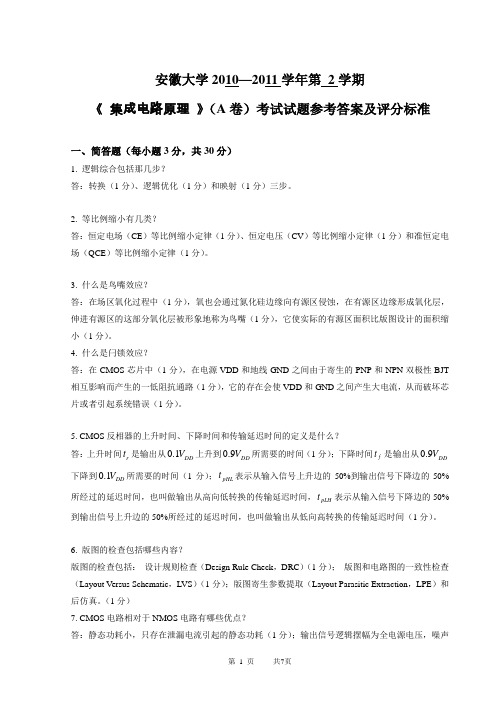
安徽大学2010—2011学年第 2学期《 集成电路原理 》(A 卷)考试试题参考答案及评分标准一、简答题(每小题3分,共30分)1. 逻辑综合包括那几步?答:转换(1分)、逻辑优化(1分)和映射(1分)三步。
2. 等比例缩小有几类?答:恒定电场(CE )等比例缩小定律(1分)、恒定电压(CV )等比例缩小定律(1分)和准恒定电场(QCE )等比例缩小定律(1分)。
3. 什么是鸟嘴效应?答:在场区氧化过程中(1分),氧也会通过氮化硅边缘向有源区侵蚀,在有源区边缘形成氧化层,伸进有源区的这部分氧化层被形象地称为鸟嘴(1分),它使实际的有源区面积比版图设计的面积缩小(1分)。
4. 什么是闩锁效应?答:在CMOS 芯片中(1分),在电源VDD 和地线GND 之间由于寄生的PNP 和NPN 双极性BJT 相互影响而产生的一低阻抗通路(1分),它的存在会使VDD 和GND 之间产生大电流,从而破坏芯片或者引起系统错误(1分)。
5. CMOS 反相器的上升时间、下降时间和传输延迟时间的定义是什么?答:上升时间r t 是输出从DD V 1.0上升到DD V 9.0所需要的时间(1分);下降时间f t 是输出从DD V 9.0下降到DD V 1.0所需要的时间(1分);pHL t 表示从输入信号上升边的50%到输出信号下降边的50%所经过的延迟时间,也叫做输出从高向低转换的传输延迟时间,pLH t 表示从输入信号下降边的50%到输出信号上升边的50%所经过的延迟时间,也叫做输出从低向高转换的传输延迟时间(1分)。
6. 版图的检查包括哪些内容?版图的检查包括: 设计规则检查(Design Rule Check ,DRC )(1分); 版图和电路图的一致性检查(Layout Versus Schematic ,LVS )(1分);版图寄生参数提取(Layout Parasitic Extraction ,LPE )和 后仿真。
数字电子技术期末考试试题含答案

《数字电子技术》考试试卷(第一套)课程号2904025035 考试时间100 分钟适用专业年级(方向):应用物理、电信科技2010级考试方式及要求:闭卷笔试题号一二三四五六七总分得分阅卷人(注:集成电路CD4532、74HC138、74HC151的功能见附表)一、填空题(共28分)1、(2分)(5E.8)H=(94.5 )D=(10010100.0101 )8421BCD。
2、(2分)逻辑函数L = + A+ B+ C +D = (1 )。
3、(2分)由传输门构成的电路如下图所示,当A=0时,输出L= B 。
4、(2分)三态门可能输出的三种状态是低电平、高电平和高阻态_。
5、(3分)A/D转换器一般要经过_ 采样__、保持、量化和__编码__这4个步骤,A/D转换器的转换速度主要取决于转换类型。
对双积分型A/D 转换器、并行比较型A/D转换器和逐次比较型A/D转换器的相对速度进行比较,转换速度最快的是_并行比较型A/D转换器__。
6、(2分)集成优先编码器CD4532(功能表见后)正常接电源和地,且待编码信号输入端I 0 =I 2 = I 6 = I 7 = 1,输入使能端EI=1,其余输入端为0,其输出Y 2Y 1Y 0为 111 。
7、(3分)集成数据选择器74HC151构成的电路如下图所示,则其输出 Y= ABC BC A C B A ++⋅⋅ 。
(注:不需化简)018、(3分)某PLA 电路如下图所示,其输出逻辑函数表达式X=C B A C B A ABC +⋅+ 。
9、(2分)某单极性输出的8位D/A 转换器正常工作,当输入数字量为(10101010)B 时,其输出电压为3.4V ,当输入数字量为(10101100)B 时,其输出电压为3.44 V 。
10、(2分)一个存储容量为4K ×4的存储器有 214 个存储单元,若用该存储器构成32K ×8的存储系统,则需 16 片4K ×4的存储器。
数字集成电路第二版答案

数字集成电路第二版答案【篇一:《数字集成电路》期末试卷a(含答案)】考试试卷 a姓名学号班级任课教师一、填空题(本大题共10小题,每空格1分,共10分)请在每小题的空格中填上正确答案。
错填、不填均无分。
1.十进制数(68)10对应的二进制数等于;2.描述组合逻辑电路逻辑功能的方法有真值表、逻辑函数、卡诺图、逻辑电路图、波形图和硬件描述语言(hdl)法等,其中描述法是基础且最直接。
3.a?1可以简化为4.图1所示逻辑电路对应的逻辑函数l等于。
abc≥1lcy图1图25.如图2所示,当输入c是(高电平,低电平)时,y?ab。
6.两输入端ttl与非门的输出逻辑函数z?ab,当a=b=1时,输出低电平且vz=0.3v,当该与非门加上负载后,输出电压将(增大,减小)。
7.moore型时序电路和mealy型时序电路相比,型电路的抗干扰能力更强。
8.与同步时序电路相比,异步时序电路的最大缺陷是会产生 9.jk触发器的功能有置0、置1、保持和的ram。
二、选择题(本大题共10小题,每小题2分,共20分)在每小题列出的四个备选项中只有一个是符合题目要求的,请将其代码填写在题后的括号内。
错选、多选或未选均无分。
11.十进制数(172)10对应的8421bcd编码是。
【】a.(1111010)8421bcdb.(10111010)8421bcdc.(000101110010)8421bcd d.(101110010)8421bcd12.逻辑函数z(a,b,c)?ab?ac包含【】a.2 b.3c.4d.513.设标准ttl与非门z?ab的电源电压是+5v,不带负载时输出高电平电压值等于+3.6v,输出低电平电压值等于0.3v。
当输入端a、b电压值va=0.3v,vb=3.6v和va=vb=3.6v两种情况下,输出电压值vz分别为。
a.5v,5v c.3.6v,0.3v【】b.3.6v,3.6v d.0.3v ,3.6v14.图3所示电路的输出逻辑函数z1等于。
2010-2011第二学期B卷参考答案及评分标准

2010-2011第二学期B卷参考答案及评分标准安徽大学2010—2011学年第2学期《集成电路原理》(B卷)考试试题参考答案及评分标准一、名词解释题(每小题3分,共15分)1. EDA:Electronic Design Automatic (2分)电子设计自动化(1分)。
2. DRC:Design Rule Check (2分)设计规则检查(1分)。
3.TSPC:True Single Phase Clock (2分)真正的单相时钟(1分)。
4. ASIC:Application Specific Integrated Circuit (2分)专用集成电路(1分)。
5. ULSI:Ultra Large Scale Integrated Circuits (2分)甚大规模集成电路(1分)。
二、编程题(20分)设计一个时钟电路,具有时/分/秒计数功能,完成12小时计数。
答:module counter_h12 (clk, rst, s, m, h);input clk, rst;output [5:0] s, m;output [3:0] h;reg [5:0] s, m; (5 分)always@(posedge clk or posedge rst)if(rst)s<=6’b000000;else if (s= =6’b111011)s<=6’b000000;elses<=s+1; (5 分)always@( posedge clk or posedge rst)if (rst)m<=6’b000000;else if (s= =6’b111011)beginif(m= =6’b111011)m<=6’b000000;elsem<=m+1;end (5 分)always@( posedge clk or posedge rst)if(rst)h<=4’b0000;else if ((s= =6’b111011)&&(m= = 6’b111011))beginif(h= =4’b1011)h<=4’b0000;elseh<=h+1;endendmodule (5 分)三、简答题(每小题4分,共20分)1.集成电路的设计方法分为哪三种?答:基于PLD的设计方法(2分),半定制设计方法(1分),定制设计方法(1分)。
模拟数字电路11级A卷

浙江科技学院考试试卷浙江科技学院2012 - 2013 学年第 二 学期考试试卷 A 卷考试科目 模拟与数字电子技术 考试方式 闭卷 完成时限 2小时 拟题人 审核人 批准人 2013 年_7 月_1 日 信息 学院 11 年级 计算机 专业命题:一、填空题。
在题中“ ”处填上答案。
(本大题共10空,共10分)1.PN 结________________时电流很小。
2.晶体三极管B JT 是一种用_________________控制输出电流的器件。
3. CMOS 集成门电路比TTL 集成门电路功率损耗小,但运行速度_______。
4.理想集成运算放大器的输入电阻是____________。
5.加入电压负反馈可以稳定输出电压,同时可使输出电阻___________。
6. 有一个负反馈放大电路,已知A=300,F=0.01,A F =___________。
7.用三极管构成非门时,它工作在_____________和饱和状态。
8.___________的输出端除出现高电平和低电平以外,还出现第三种状态-----高阻。
9.实现两个一位二进制数相加且考虑来自低位进位的电路是__________。
10.能将___________转换成模拟量的电路为D/A 转换器。
二、单项选择题。
在题中“ ”处,填上正确答案代号。
(本大题共10小题,每空2分,共20分) 1、纯净半导体晶体也叫 。
A 、P 型半导体B 、N 型半导体C 、本征半导体2、某晶体管的I b 从20μA 变到40μA 时,对应的Ic 从1.55mA 变化到2.55mA ,则该管的β为___________。
A 、75B 、50C 、100D 、77.5专业班级 学号 姓名………………………………………………………………………装订线……………………………………………………………………………………3、对放大电路进行等效电路法动态分析的主要任务是________。
07-08学年第二学期 数字集成电路基础 课程期末试卷(A)
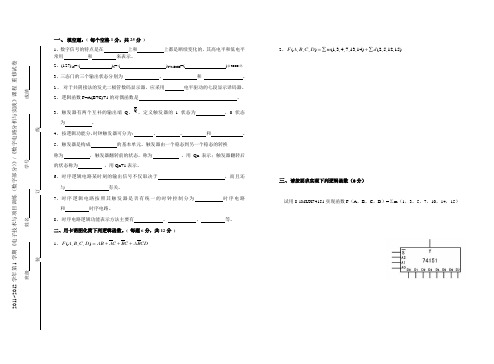
一、 填空题:( 每个空格1分,共25分 )1、数字信号的特点是在 上和 上都是断续变化的,其高电平和低电平常用 和 来表示。
2、(127)10= ( )2= ( )8421BCD =( )余3BCD 码3、三态门的三个输出状态分别为 、 和 。
1、 对于共阴接法的发光二极管数码显示器,应采用 电平驱动的七段显示译码器。
2、 逻辑函数F=A(B+C)+1的对偶函数是 。
3、 触发器有两个互补的输出端Q 、Q ,定义触发器的1状态为 ,0状态为 。
4、 按逻辑功能分,时钟触发器可分为: 、 、 和 。
5、 触发器是构成 的基本单元。
触发器由一个稳态到另一个稳态的转换 称为 ,触发器翻转前的状态,称为 ,用 Qn 表示;触发器翻转后的状态称为 ,用Qn+1表示。
6、 时序逻辑电路某时刻的输出信号不仅取决于 ,而且还 与 有关。
7、 时序逻辑电路按照其触发器是否有统一的时钟控制分为 时序电路 和 时序电路。
8、 时序电路逻辑功能表示方法主要有 、 、 等。
二、用卡诺图化简下列逻辑函数。
( 每题6分,共12分 ) 1、(,,,)F A B C D AB A C BC ABCD =+++2、(,,,)(1,3,4,7,13,14)(2,5,12,15)F A B C D m d =∑+∑三、请按要求实现下列逻辑函数(6分)试用8-1MUX74151实现函数F (A ,B ,C ,D )=Σm (1,3,5,7,10,14,15)装 订 线 班级 姓名 学号成绩 2011~2012学年第1学期《电子技术与项目训练(数字部分)》/《数字电路分析与实践》课程 重修试卷四、设计一个A 、B 、C 三变量的判偶电路,三个变量中,1的个数为偶数时,输出为1,否则输出为0。
采用与非门实现之。
(1)分析设计要求,确定逻辑变量。
(2分) (2) 根据题意,列出真值表。
(3分) (3)写逻辑函数表达式,并化简。
(3分) (4)画逻辑电路图。
电子科大2011数字电路期中考试

电子科技大学二零零九年至二零一零学年第二学期“数字逻辑设计及应用”课程考试题(半期)(120分钟)考试日期2011年4月23日I. To fill the answers in the “( )”(2’ X 19=38)1. [1776 ]8= ( 3FE)16 = ( 1111111110)2= ( 1000000001) Gray .2. (365)10 = ( 001101100101)8421BCD=( 001111001011) 2421 BCD.3. Given an 12-bit binary number N. if the integer’s part is 9 bits and the fraction’s part is 3 bits ( N = a8 a7 a6a5a4a3a2a1a0 . a-1a-2a-3), then the maximum decimal number it can represent is ( 511.875 ); the smallest non-zero decimal number it can represent is ( 0.125).4.If X’s signed-magnitude representation X SM is(110101)2, then it’s 8-bit two’s complement representation X2’s COMP is( 11101011 ) , and (–X)’s 8-bit complement representation (–X) 2’sis ( 00010101 )2 .COMP5. If there are 2011 different states, we need at least ( 11 ) bits binary code to represent them.6.If a positive logic function expression is F=AC’+B’C(D+E),then the negative logic function expression F = ( (A+C’)(B’+(C+DE)) ).7. A particular Schmitt-trigger inverter has V ILmax = 0.7 V, V IHmin = 2.1 V, V T+ = 1.7 V, and V T-= 1.3 V, V OLmax=0.3V, V OHmin=2.7V. Then the DC noise margin in the HIGH state is ( 0.6V), the Arrayhysteresis is ( 0.4V).8.The unused CMOS NAND gate input in Fig. 1 should be tied tologic ( 1 ).Fig.1Circuit of problem I-89. If number [ A ] two’s-complement =11011001and [ B]two’s-complement=10011101 , calculate[-A-B ]two’s-complement, [-A+B ]two’s-complement and indicate whether or not overflow occurs.[-A-B ]two’s-complement=[ 10001010], overflow: [ yes ][-A+B ]two’s-complement=[ 11000100], overflow: [ no].10.The following logic diagram Fig.2 implements a function of 3-variable with a 74138. The logic function can be expressed as F (A,B,C) = ∑A,B,C ( 0,1,2 ).Fig.2 Circuit of problem I-10评分基本标准: 每空1分,错则全扣。
《数字集成电路》期末试卷A(含答案)
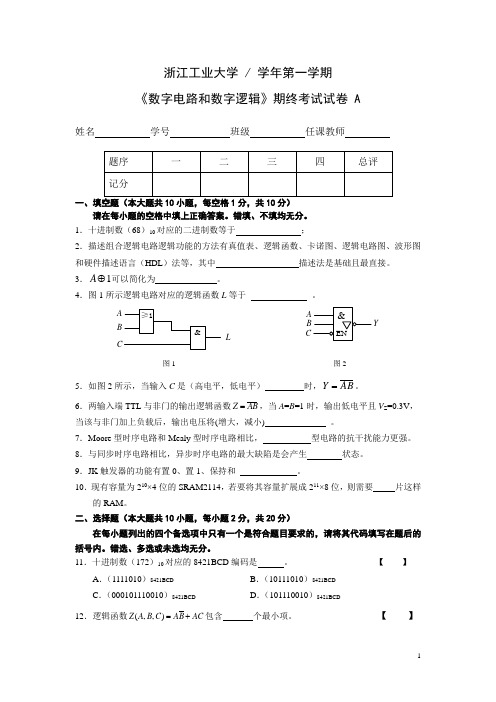
浙江工业大学 / 学年第一学期 《数字电路和数字逻辑》期终考试试卷 A姓名 学号 班级 任课教师一、填空题(本大题共10小题,每空格1分,共10分)请在每小题的空格中填上正确答案。
错填、不填均无分。
1.十进制数(68)10对应的二进制数等于 ;2.描述组合逻辑电路逻辑功能的方法有真值表、逻辑函数、卡诺图、逻辑电路图、波形图和硬件描述语言(HDL )法等,其中 描述法是基础且最直接。
3.1A⊕可以简化为 。
4.图1所示逻辑电路对应的逻辑函数L 等于 。
A B L≥1&CYC图1 图25.如图2所示,当输入C 是(高电平,低电平) 时,AB Y =。
6.两输入端TTL 与非门的输出逻辑函数AB Z =,当A =B =1时,输出低电平且V Z =0.3V ,当该与非门加上负载后,输出电压将(增大,减小) 。
7.Moore 型时序电路和Mealy 型时序电路相比, 型电路的抗干扰能力更强。
8.与同步时序电路相比,异步时序电路的最大缺陷是会产生 状态。
9.JK 触发器的功能有置0、置1、保持和 。
10.现有容量为210×4位的SRAM2114,若要将其容量扩展成211×8位,则需要 片这样的RAM 。
二、选择题(本大题共10小题,每小题2分,共20分)在每小题列出的四个备选项中只有一个是符合题目要求的,请将其代码填写在题后的括号内。
错选、多选或未选均无分。
11.十进制数(172)10对应的8421BCD 编码是 。
【 】A .(1111010)8421BCDB .(10111010)8421BCDC .(000101110010)8421BCD D .(101110010)8421BCD12.逻辑函数AC B A C B A Z +=),,(包含 个最小项。
【 】A .2B .3C .4D .513.设标准TTL 与非门AB Z =的电源电压是+5V ,不带负载时输出高电平电压值等于+3.6V ,输出低电平电压值等于0.3V 。
数电期末试卷与答案(共4套)
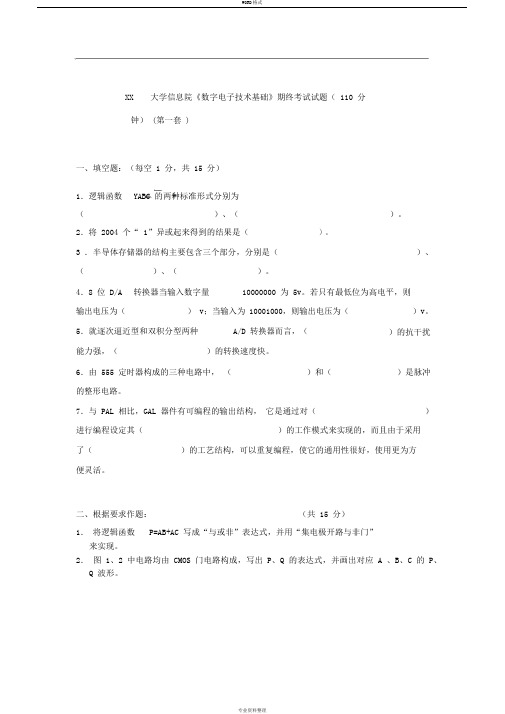
XX大学信息院《数字电子技术基础》期终考试试题( 110 分钟) (第一套 )一、填空题:(每空 1 分,共 15 分)1.逻辑函数YABC 的两种标准形式分别为()、()。
2.将 2004 个“ 1”异或起来得到的结果是()。
3 .半导体存储器的结构主要包含三个部分,分别是()、()、()。
4.8 位 D/A 转换器当输入数字量10000000 为 5v。
若只有最低位为高电平,则输出电压为() v;当输入为 10001000,则输出电压为()v。
5.就逐次逼近型和双积分型两种A/D 转换器而言,()的抗干扰能力强,()的转换速度快。
6.由 555 定时器构成的三种电路中,()和()是脉冲的整形电路。
7.与 PAL 相比,GAL 器件有可编程的输出结构,它是通过对()进行编程设定其()的工作模式来实现的,而且由于采用了()的工艺结构,可以重复编程,使它的通用性很好,使用更为方便灵活。
二、根据要求作题:(共 15 分)1.将逻辑函数P=AB+AC 写成“与或非”表达式,并用“集电极开路与非门”来实现。
2.图 1、2 中电路均由 CMOS 门电路构成,写出 P、Q 的表达式,并画出对应 A 、B、C 的 P、Q 波形。
三、分析图 3 所示电路:(10 分)1)试写出 8 选 1 数据选择器的输出函数式;2)画出 A2、 A1、 A0 从 000~111连续变化时, Y 的波形图;3)说明电路的逻辑功能。
四、设计“一位十进制数”的四舍五入电路(采用8421BCD 码)。
要求只设定一个输出,并画出用最少“与非门”实现的逻辑电路图。
(15 分)五、已知电路及、4(a) (b)所示,设触发器的初态均为“ 0”,试CP A 的波形如图画出输出端 B 和 C 的波形。
(8 分)BC六、用 T 触发器和异或门构成的某种电路如图5(a)所示,在示波器上观察到波形如图 5(b)所示。
试问该电路是如何连接的?请在原图上画出正确的连接图,并标明 T 的取值。
数字电子技术期末考试题及答案(经典)
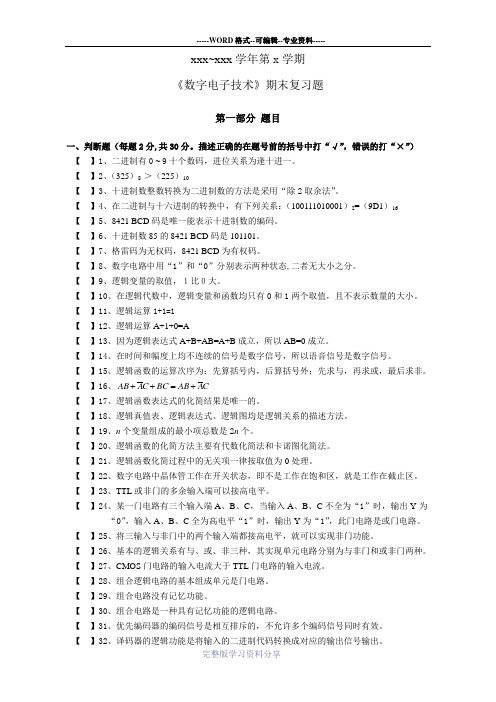
xxx~xxx学年第x学期《数字电子技术》期末复习题第一部分题目一、判断题(每题2分,共30分。
描述正确的在题号前的括号中打“√”,错误的打“×”)【】1、二进制有0 ~ 9十个数码,进位关系为逢十进一。
【】2、(325)8 >(225)10【】3、十进制数整数转换为二进制数的方法是采用“除2取余法”。
【】4、在二进制与十六进制的转换中,有下列关系:(100111010001)2=(9D1)16【】5、8421 BCD码是唯一能表示十进制数的编码。
【】6、十进制数85的8421 BCD码是101101。
【】7、格雷码为无权码,8421 BCD为有权码。
【】8、数字电路中用“1”和“0”分别表示两种状态,二者无大小之分。
【】9、逻辑变量的取值,1比0大。
【】10、在逻辑代数中,逻辑变量和函数均只有0和1两个取值,且不表示数量的大小。
【】11、逻辑运算1+1=1【】12、逻辑运算A+1+0=A【】13、因为逻辑表达式A+B+AB=A+B成立,所以AB=0成立。
【】14、在时间和幅度上均不连续的信号是数字信号,所以语音信号是数字信号。
【】15、逻辑函数的运算次序为:先算括号内,后算括号外;先求与,再求或,最后求非。
【】16、AB A C BC AB A C++=+【】17、逻辑函数表达式的化简结果是唯一的。
【】18、逻辑真值表、逻辑表达式、逻辑图均是逻辑关系的描述方法。
【】19、n个变量组成的最小项总数是2n个。
【】20、逻辑函数的化简方法主要有代数化简法和卡诺图化简法。
【】21、逻辑函数化简过程中的无关项一律按取值为0处理。
【】22、数字电路中晶体管工作在开关状态,即不是工作在饱和区,就是工作在截止区。
【】23、TTL或非门的多余输入端可以接高电平。
【】24、某一门电路有三个输入端A、B、C,当输入A、B、C不全为“1”时,输出Y为“0”,输入A、B、C全为高电平“1”时,输出Y为“1”,此门电路是或门电路。
数字集成电路期末考试卷B-2012

第 2 页 共 2页
图1
第 1 页 共 2页
2.
在CMOS 0.18um工艺模型中,一个nFET的W=9um,L=0.18um,其工艺互导为k′n=90uA/V2, VTn=0.45V。假设Vsb=0。 (每小题5分,n=2.0V 时的 MOS 管导通电阻。 (2)计算电压设定为 VGSn=2.0V,VDSn=1.1V 时的 MOS 管导通电阻。
kn 。 = 1.5 三输入的或非门 y = a + b + c 的逻辑努力是( 12 ) kp
6.工艺的氧化层厚度 tox=10 nm ( ε ox = 3.453 × 10−13 F/cm),载流子迁移率为µn=520 cm2 / (V· s) , µp= 260 cm2 / (V· s),若一个 nFET 和 pFET,W=16µm,L= 0.5µm,栅电压 VG=4V,而阈值电 压 VTn=0.8V,VTp= − 1V, 则 Rn=( 13 ); Rp=( 14 ); 若保持 nFET 尺寸不变 而增加 pFET 的宽度,使 Rp = 0.8Rn, pFET 的宽度 W=( 15 ). 二、问答题(15%) (1)MOS管的窄沟道效应和短沟道效应的定义分别是什么? (2)动态 CMOS 逻辑电路的定义是什么? (3)闩锁效应的形成原因及其预防措施? 三、综合题(55%) 1. 图1为阻性负载的反相器电路。电源电压VDD为5V,MOS管的工艺互导为20uA/V2,阈值电 压为0.8V,负载电阻RL为200K,W/L=2。计算该反相器的传输特性数值(VIL,VOL,VIH, VOH)及电路的噪声容限,并在此基础上评价该反相器的设计是否最优。 (11分)
华
日
侨
大
学
数字集成电路设计
中国科学技术大学期末考试试卷

一、填空题1.常用的并行算法设计的基本技术有_______ _________,___________________,_______________________,____________ ______,_____________________,_______________________等。
2.常见的并行计算模型有____________ ______,_____________________,_______________________,____________ ______等。
3.PCAM设计过程分为_________,__________,_________ 和_________四步。
4.常见的并行程序设计模型包括__ ___________,__ _____________,______________________,______________________等。
二、问答题1.请简述从上个世纪80年代至今,主流并行计算机体系结构的变化趋势。
2.基于蝶式计算原理的FFT在二维mesh连接和蝶式网络连接的处理器上均可并行实现。
(1)请问哪种实现效率较好?并给出原因。
(2)蝶式网络连接的处理器在实际的并行计算机系统并不常见,这是否会影响FFT在蝶式网络连接上的并行实现在实际中的使用?为什么?3.基本的开关技术有哪两种?各具有什么特点?三、阅读题1.阅读以下新闻报道,回答问题。
2004 年6月29日国家科技部今日在人民大会堂宣布:“863计划重点项目——曙光4000A通过鉴定验收,曙光4000A实现了对每秒10万亿次运算速度的技术和应用的双跨越,成为国内计算能力最强的商品化超级计算机”。
在今年6月22日刚刚公布的全球高性能计算机TOP500排行榜中,曙光4000A以每秒11万亿次的峰值速度和80610亿次Linpack计算值位列全球第十,这是中国超级计算机得到国际同行认可的最好成绩。
- 1、下载文档前请自行甄别文档内容的完整性,平台不提供额外的编辑、内容补充、找答案等附加服务。
- 2、"仅部分预览"的文档,不可在线预览部分如存在完整性等问题,可反馈申请退款(可完整预览的文档不适用该条件!)。
- 3、如文档侵犯您的权益,请联系客服反馈,我们会尽快为您处理(人工客服工作时间:9:00-18:30)。
Digital Integrated Circuits
Final Exam, Fall 2011
School of Software Engineering
University of Science and Technology of China
(19:00pm–21:00 pm November24th, 2011)
Name:Student ID:Score:
1. Which of the following two circuits is better in terms of speed? Why?(5 points)
2. Describe at least two methods to reduce power dissipation of digital integrated circuits. (5 points)
3. What are the advantage and disadvantage of using the transistor M r in the figure below? (4 points)
4.Reconstruct the following circuit logically to avoid glitches.Describe at least one other method to avoid glitches. (5 points)
5.Sketch a transistor-level circuit for a 6-Transistor SRAM. Describe how to size transistors to ensure writing reliability and reading stability.What is the purpose of having PMOS transistors? (10 points)
6.Consider a 24-bit, 6 stage carry-bypass adder with the following delays: t setup=4, t carry=1, t sum=4, t bypass
=2.
b) Consider the setup delay and carry propagation of the2nd, 3rd, and 4th stages.It is not on the critical path and can be made slower without affecting performance. If each stage is allowed to handle a different number of bits,how many bits would you assign to each of the first four stages to minimize the delay from inputs to the carry output
for the first16 bits of the adder?(6 points)
c)Given the condition that the number of bits in the last two stages is 8, how many bits would you assign to each of the last two stages to minimize the delay of the adder?
(4 points)
7. Assume the registers in the following figure are edge triggered with t clk-q, max= 4ns, t clk-q, min = 2ns, t setup = 1ns, and t hold= 1ns:
CLK
(a) What is the maximum operating frequency of this system if there is no skew and jitter? (8 points)
(b) What is the maximum random clock skew that this system can tolerate? (6 points)
8.Throughout this problem assume that the drain capacitance in the following figure,
C D = 0.
a) Assuming P(A=0)= P(B=0) = P(C=0) = P(D=0)=0.5, what are the activity factors (i.e.,α0→1) at each of the nodes n0– n3?(6 points)
b) Assuming the circuit operates with a supply voltage V DD and a clock frequency f, what is the total dynamic power consumed by this circuit as a function of Cin, C1, C2, and C L (as labeled above)? Note that you should include the power dissipated by driving the A, B, C, and D inputs.(7 points)
c)Using the method of logical effort, calculate the delay from A to n2 ((in units of t inv) as a function of Cin, C1, C2, and CL.(5 points)
9. Sketch a transistor-level circuit for a master-slave positive edge-triggered register which consists of transmission gates. Express t setup and t hold in terms of t pd_inv(the delay of an inverter) and t pd_tx (the delay of a transmission gate). (7 points)
10.What is the logic function performed by this circuit? What is the purpose of having the transistor M1? (4 points)
11. Assume that the threshold voltage of NMOS transistors V TN = 0.4V. Calculate the voltage of nodes A and B respectively? (4 points)
12.Consider the figure below. During the precharge phase, the output node is precharged to V DD. Assume that all inputs are set to zeros during precharge, and that the capacitance C a is discharged。
Assume further that input B remains at 0 during evaluation, while input A makes a0—>1transition,turning M a on.Calculate the
voltage drop of the output nodeΔV out.(4 points)。
